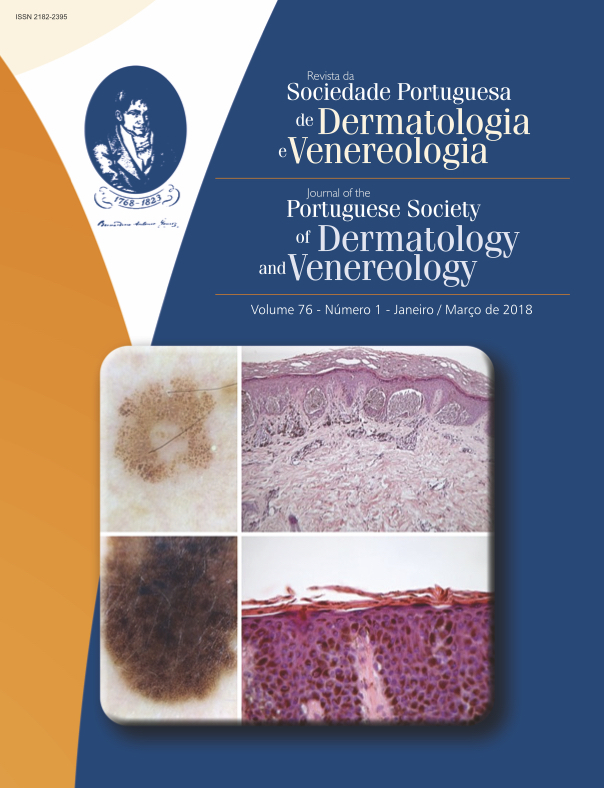Neurotequeoma Celular em Criança: Descrição de um Caso Invulgar e Breve Revisão da Literatura
Resumo
O neurotequeoma é uma neoplasia benigna, rara, cuja histiogénese permanece incerta. Os avanços nos estudos com a imunohistoquímica, no entanto, permitiriam o reconhecimento de uma possível origem na linhagem fibrohistiocitária. Histopatologicamente são reconhecidas três variantes de acordo com a quantidade de matriz mixóide e com a análise imunohistoquímica: mixóide, celular ou misto. Os raros casos reportados, localizaram-se sobretudo na cabeça, pescoço e membros superiores, em mulheres jovens. Na revisão da literatura não há referência às características dermatoscópicas do neurotequeoma. Neste contexto, descrevemos o caso invulgar de um neurotequeoma celular, localizado na axila de uma criança de 7 anos, do sexo feminino, e respectivos achados dermatoscópicos.
Downloads
Referências
Hornick JL, Fletcher CD. Cellular neurothekeoma: detailed characterization in a series of 133 cases. Am J Surg Pathol. 2007;31:329-40.
Rosati LA, Fratamico FC, Eusebi V. Cellular neurothekeoma. Appl Pathol. 1986;4:186-91.
Fetsch JF, Laskin WB, Hallman JR. Neurothekeoma: an analysis of 178 tumors with detailed immunohistochemical data and long-term patient follow-up information. Am J Surg Pathol. 2007;31:1103-14.
Fetsch JF, Laskin WB, Miettinen M. Nerve sheath myxoma: a clinicopathologic and immunohistochemical analysis of 57 morphologically distinctive, S-100 protein and GFAP-positive, myxoid peripheral nerve sheath tumors with a predilection for the extremities and a high local recurrence rate. Am J Surg Pathol. 2005; 29: 1615-24.
Jaffer S, Ambrosini-Spaltro A, Mancini AM, Eusebi V, Rosai J. Neurothekeoma and plexiform fibrohistiocytic tumor: mere histologic resemblance or histogenetic relationship? Am J Surg Pathol. 2009; 33: 905-13.
Barnhill RL, Dickersin GR, Nickeleit V, Bhan AK, Muhlbauer JE, Phillips ME, et al. Studies on the cellular origin of neurothekeoma: clinical, light microscopic, immunohistochemical, and ultrastructural observations. J Am Acad Dermatol. 1991;25:80-8.
Calonje E, Wilson-Jones E, Smith NP, Fletcher CD. Cellular 'neurothekeoma': an epithelioid variant of pilar leiomyoma? Morphological and immunohistochemical analysis of a series. Histopathology. 1992;20:397-404.
Misago N, Satoh T, Narisawa Y. Cellular neurothekeoma with histiocytic differentiation. J Cutan Pathol. 2003; 30:196-201.
McKee PH, Calonje E, Granter SR. Pathology of the skin with clinical correlations. Philadephia: Elsevier Mosby; 2005.
Wang GY, Nazarian RM, Zhao L, Hristov AC, Patel RM, Fullen DR, et al. Protein gene product 9.5 (PGP9.5) expression in benign cutaneous mesenchymal, histiocytic, and melanocytic lesions: comparison with cellular neurothekeoma. Pathology. 2017; 49 :44-9.
Plaza JÁ Torres-Cabala C, Evans H, Diwan AH Prieto VG. Immunohistochemical expression of S100A6 in cellular neurothekeoma: clinicopathologic and immunohistochemical analysis of 31 cases. Am J Dermatopathol. 2009; 31: 419-22
Aydingoz IE, Mansur AT, Dikicioglu-Cetin E. Arborizing vessels under dermoscopy: A case of cellular neurothekeoma instead of basal cell carcinoma. Dermatol Online J. 2013;19: 5.
Papadopoulos EJ, Cohen PR, Hebert AA. Neurothekeoma: report of a case in an infant and review of the literature. J Am Acad Dermatol. 2004; 50:129-34.
Ferrari A, Soyer HP, Peris K, Argenziano G, Mazzocchetti G, Piccolo D et al. Central white scarlike patch: a dermatoscopic clue for the diagnosis of dermatofibroma. J Am Acad Dermatol. 2000; 43:1123-5.
Karaarslan KI, Gencoglan G, Akalin T, Ozdemir F. Different dermoscopic faces of dermatofibromas. J Am Acad Dermatol. 2007; 57:401-6.
Todos os artigos desta revista são de acesso aberto sob a licença internacional Creative Commons Attribution-NonCommercial 4.0 (CC BY-NC 4.0).








